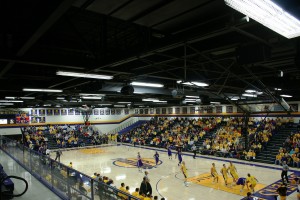In Steven’s Point, Wisconsin, hockey and figure skating are staple activities within the local sports community. Willett Ice Arena, part of the City of Stevens Point park system, is a hub for community spectators as well as the home to both hockey and figure skating teams from Stevens Point Area Senior High School and University of Wisconsin Stevens Point. Located just a mile away is Soundworks Systems, Inc., an integrator who was called on to help make the audio more intelligible and enjoyable for the thousands people attending the ice arena each year. Soundworks installed a comprehensive loudspeaker solution that was driven by Ottocanali and Duecanali amplifiers from Powersoft.
Willett Ice Arena, which is a regulation size rink with seating on three sides, has a capacity of approximately 1,800 spectators. It was built using a ‘bowl style’ construction technique, with the rink itself located several feet below grade level and seats rising around it in an ascending fashion. The rink itself has many acoustic challenges, including reflections and obstructions from the plexiglass surrounding the rink, as well as reflections from the ice itself. The previous audio system fell short of meeting the needs of both the venue and spectators, and consisted principally of single cluster located above center ice, firing outward towards the seating area.
Screaming fans, challenging acoustics
“The system was wholly inadequate and there were many intelligibility issues,” says Brian Baumann of Soundworks. “One speaker was pointed in each direction, hanging from a custom made mount, and was just turned up as loud as it could go. It was not only hitting the reflective surface of the rink, but it was not reaching the hundreds of fans seated behind the plexiglass on the perimeter of the rink, which is approximately nine feet high.”
High school and university sporting events — particularly those that are running indoors — typically have special requirements given the unbridled enthusiasm of fans: “University hockey games get loud and crazy,” Baumann explains. “So the speaker system for the folks attending needs to be really strong and clear, so everybody knows what’s going on.” This is true for both fans that want to hear routine updates from the announcers on scoring, penalties and substitutions, but also for ice dancers and figure skaters, who rely on audio intelligibility for their dance routines. “Timing really counts for these figure skaters, and you can’t have reflections coming back at you half a second later,” Baumann continues. “The music should also time align properly for fans, who want to experience both the musical and visual aspect of the performance.”
 Implementing a time-aligned, multi-zone system
Implementing a time-aligned, multi-zone system
After running computer models, Soundworks decided to go with a nine-zone system consisting of 14 speakers, driven by Powersoft Ottocanali and Duecanali amplifiers. “The first thing we had to do was figure out how to get the audio over that glass and down into the seats where he people are,” says Baumann. “Once we see the 3D coverage patterns in our computer models, we choose the appropriate speakers to fit, then decide how to power them. We chose the Ottocanali and Duecanali because of their sonic quality, reliability, small form factor and the perfect output power ratings for our application.”
Soundworks chose One Systems 112IM 12″ two-way loudspeakers throughout — four on each long side of the rink, and two on the short side of the rink with spectators. Mounted above the ice are four speakers spaced about 50′ apart, and another pair of speakers along a set of bleachers over the main seating area. By setting the speakers up on nine different zones, Baumann and his team were able to time align the system to ensure proper arrival times.
 Ottocanali and Duecanali: the power to engage
Ottocanali and Duecanali: the power to engage
When considering the amplification, attaining power in a compact package was the first order of business. “We wanted something that was compact in a rack, but powerful enough to run the entire loudspeaker system,” says Baumann. “We also wanted something we could rely on. We knew that by installing Powersoft, we were putting in a high-grade professional product.”
The Duecanali 3904 were used to drive the speakers located in the audience seating area, with the remaining three channels covering three of the speakers across the ice. An Ottocanali 12K4 was used to drive the remaining channel on the ice, as well as the facility’s game room, snack bar, hallways and bathrooms.
“We looked at the entire Powersoft line to see what power requirements fit what we were doing, and Ottocanali and Duecanali just fit the best,” says Baumann The Ottocanali and Duecanali also took up a very modest amount of space in the control room: “There was an existing rack in the office, and with too many pieces of gear, heat buildup becomes a concern. The Powersoft amps kept the rack wide open and the equipment stayed nice and cool.”
Baumann says that the amplification has made all the difference in the system at Willett Ice Rink, and has literally transformed the experience for fans, athletes and performers: “It is fantastic,” he says. “The system is very responsive and super-clear. Before, the university students couldn’t hear what was going on. Now, everybody knows the score, which player is going in and coming off the ice, what the penalties are. They are clearly more engaged in the events.”



